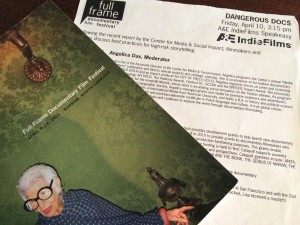 At the 18th annual Full Frame Documentary Film Festival, Angelica Das, associate director at CMSI, joined filmmakers and funders to discuss best practices for high-risk storytelling. Using the Center’s recent report “Dangerous Docs” as a catalyst, this conservation looked specifically at the relationship of funders and risk.
At the 18th annual Full Frame Documentary Film Festival, Angelica Das, associate director at CMSI, joined filmmakers and funders to discuss best practices for high-risk storytelling. Using the Center’s recent report “Dangerous Docs” as a catalyst, this conservation looked specifically at the relationship of funders and risk.
Lisa Kleiner Chanoff, co-founder of Catapult Film Fund, and Jenny Raskin, VP for Development and Filmmaker Relations at Impact Partners, agreed that in their position as funders, support for filmmakers regarding risk is reactive. According to Chanoff, it is a process that relies on informal meetings and creating mentorships. Funders like Catapult make an effort to connect their filmmakers with experts or others with relevant experience.
Katy Chevigny (E-TEAM) spoke about her experience being connected to young Ukrainian filmmakers to give advice about working in a dangerous situation. In general, Chevigny claims “a part of filmmaking is risk taking, period. Is there a movie there? That’s a risk.” So, when dealing with a project that contains many layers of risk and vulnerability (physical safety, data protection, economic risk) there is no easy solution. However, having a safe space to communicate those vulnerabilities would be a huge asset to filmmakers.
Das shared that this was a recurring sentiment in the interviews for the “Dangerous Docs” report. Often, filmmakers would lament, “I wish I could pick up the phone and call…”
When asked where to find resources (now or in the future), Chevigny praised the type of “decentralized support” the “Statement of Best Practices in Fair Use for Documentary Filmmakers” became for the industry. Filmmaker and film educator, Marco Williams (The Undocumented), followed with the need for a repository of ideas and questioned who would paid professionals would be accountable to if hired to serve the broadest groups?
Williams also suggested that funders could help tackle the financial requirements of risk assessment by adding 10% to budgets to pay for experts when the need arises. In many cases, this is the barrier to ensuring proper assessment. Chevigny noted that much of the success she’s experienced was when her team had an organization to piggyback on. Large institutions have the capacity to assess risk because they already have legal representative to handle those situations.
At the end of the conversation, Full Frame Director Deirdre Haj posed the question of the possibility for an umbrella organization that could take on this challenge. If more filmmakers had the kind of public endorsement that, for example, Laura Poitras has as the recipient of a MacArthur Fellows award, perhaps they would be better protected. Haj suggested that other funders either individually or as a coalition could more often publicly stand behind their risk-taking filmmakers.
Chanoff replied that there will always be funders doing this type of work, however there was not yet indication of an umbrella organization coming forward.
Some suggestions/ideas/requests that came out of this conversation from panelists and audience alike:
- Greater visibility for filmmakers doing high-risk work
- Access to mentorship from filmmakers who have faced similar risks
- A convening of funders to discuss needs
- A consortium of funders to provide support for filmmakers
- A repository of information or best practices
Overall, the panel agreed that resources for filmmakers and funders dealing with high-risk storytelling are lacking in a concise, approachable form. The current informal network of connections may no longer be sufficient to address the current challenges filmmakers face in areas of security and publicity.
Read more about the Dangerous Docs report and watch the Full Frame panel online [not yet posted].
